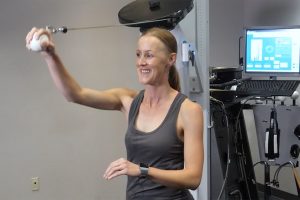
New Clinical Practice Guideline for Shoulder Pain Makes the Case Against Surgery
Treatment GuidelinesThe paper's authors summarized their evidence-based recommendations into a new Clinical Practice Guideline (CPG), which can help healthcare providers and their patients make more well-informed decisions regarding their course of care.
Should patients experiencing chronic, atraumatic shoulder pain for three or more months undergo surgery?
A new paper recently published in the BMJ advises strongly against it. The paper’s authors summarized their evidence-based recommendations into a new Clinical Practice Guideline (CPG), which can help healthcare providers and their patients make more well-informed decisions regarding their course of care.
New CPG for atraumatic shoulder pain: choose exercise over surgery
This new CPG specifically applies to two types of shoulder pain, described as “subacromial pain syndrome” and “rotator cuff disease.” Historically, surgeons performed arthroscopic decompression surgery as an invasive approach to symptom management.
But after a thorough review of two systematic reviews featuring over 1,000 patients, the authors discovered two key findings:
First, decompression surgery is no more effective for relieving atraumatic shoulder pain than other treatment options—including physical therapy, analgesics, and shoulder injections. For instance, follow ups as far as two and five years out saw no significant difference in pain (as measured on the visual analog scale). The same goes for function when comparing arthroscopic surgery to other approaches.
Second, the researchers expanded their review to include observational studies evaluating post-operative harm, since “potential harms from surgery were incompletely reported” in the previous trials. They found that the risks for complications—including bleeding, infections, peripheral nerve injury, anesthetic complications, and venous thromboembolism—was approximately 0.55% after 30 days post-op.
While this may not sound like a high risk ratio, the potential severity of the complications must be considered when looking at this figure—and when driving decisions that influence patient outcomes.
Simply put: does the potential surgical risk outweigh the potential surgical benefit, especially when compared to non-surgical approaches? No, the authors conclude.
It’s also necessary to consider that recovery from subacromial decompression surgery involves a prolonged downtime lasting upwards of three months, which may include sick leave, disability, lost wages, and diminished quality of life.
The authors of this new CPG acknowledge a few limitations of the studies they used to substantiate their findings. Many studies were at high risk of bias due to lack of blinding. They also point out that the research does not specifically indicate which methods of non-surgical management (modalities, exercise, NSAIDs, etc.) are the best: “Exercise, manual therapy, and electrotherapies are of uncertain benefit to patients compared with watchful waiting, and guidelines vary in their recommendations.” Additionally, the research used to develop this CPG may not apply to patients with other types of shoulder pain, including trauma-induced.
Overall, however, the authors state that the evidence supporting the broad use of non-operative management over surgery is moderate to high in strength. They also state that key patient outcomes (including function, pain, quality of life, perceived effects, and return to work) are no better for the post-operative patient compared to the patient offered conservative management, including physical therapy and analgesics such as NSAIDs.
The authors strongly advise against surgery for this patient population and make a call to “de-implement inefficient and potentially harmful subacromial decompression surgery.”
“Clinicians should not offer patients subacromial decompression surgery unprompted,” they continue, “and others should make efforts to educate the public regarding the ineffectiveness of surgery.” They theorize that, given the facts, well-informed patients would decline surgery.
Importantly, the recommendations of this CPG are consistent with other existing CPGs regarding shoulder pain, including a 2013 CPG for adhesive capsulitis published in the Journal of Orthopedic Sports Physical Therapy.
The benefits (and drawbacks) of clinical practice guidelines in rehab
This new CPG has a valuable place in any rehab clinic working with atraumatic chronic shoulder pain patients. Indeed, well-developed and well-substantiated CPGs can improve patient outcomes and drive clinic revenue.
How? By informing and empowering patients, fostering greater trust between patients and their clinicians, and encouraging the use of interventions with stronger proven benefits compared to interventions with ineffective or harmful effects.
CPGs can also reduce unnecessary healthcare usage, and minimize heterogeneity in clinical recommendations. This is especially problematic for drawing conclusions from research in the rehabilitation field.
However, CPGs are not immune to drawbacks, including the potential of research bias and flawed data. These drawbacks must be considered, identified, and mitigated whenever possible when deciding to implement a CPG in a rehabilitation or therapy clinic.
If a CPG is effective, it must meet a few characteristics :
- Be based on systematic literature reviews
- Be developed by informed and multidisciplinary experts and representatives from affected patient populations
- Must offer a clear explanation of the relationships between alternative options and patient outcomes
- Must be rigorously based on evidence derived from explicit processes aiming to minimize bias, conflict of interest, and distortion
- Be considerate of patient values and preferences
- Provide ratings of quality of evidence and strength of recommendations
- Be revised as indicated when new evidence warrants modifications and updated recommendations
Utilizing evidence-based medicine can optimize clinic growth, and perhaps most importantly maximize patient outcomes and enhance the strength of the clinician/patient relationship. Contact BTE if you’d like to learn more about how we can help you maximize workflow and clinical decision-making at your rehabilitation clinic.
References
- APTA. 2013. APTA contributes to new ‘playbook’ on pain management and opioid stewardship. PT In Motion News. http://www.apta.org/PTinMotion/NewsNow/category=New%20in%20Research&blogid=10737418615
- Kelley, M.J., et al. 2013. Shoulder pain and mobility deficits: adhesive capsulitis. JOSPT. https://www.jospt.org/doi/pdf/10.2519/jospt.2013.0302
- Vandvik, P.O., et al. 2019. Subacromial decompression surgery for adults with shoulder pain: a clinical practice guideline. BMJ. https://www.bmj.com/content/364/bmj.l294
- Woolf, S., et al. 1999. Potential benefits, limitations, and harms of clinical guidelines. BMJ. https://www.ncbi.nlm.nih.gov/pmc/articles/PMC1114973/
- Murad, M.H. 2017. Clinical practice guidelines: a premier on development and dissemination. Mayo Clinic. https://www.mayoclinicproceedings.org/article/S0025-6196(17)30025-3/pdf





